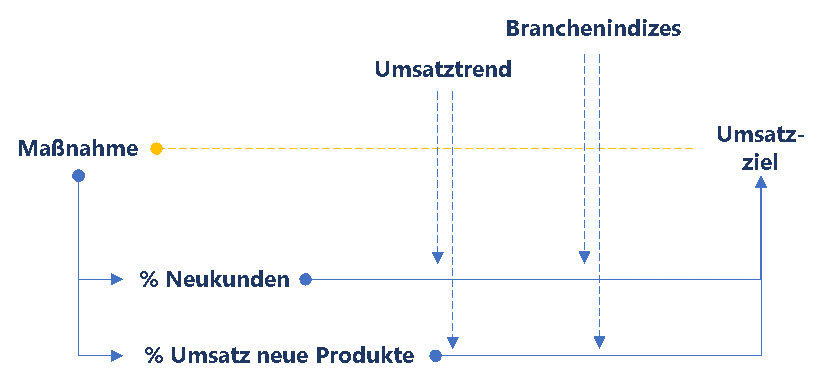Everyone knows the credo What get's measured get's done. But often it is not so easy to measure. Planning and measuring effects of measures is indeed one of the supreme disciplines of corporate transformation. We will show you how you can tackle this complex problem!

What Can Be Done Can Be Measured?
To start with, we will take a simple example today: You are an automotive supplier and manufacture cylinder heads. You have the feeling that the cost of materials is unnecessarily high. You find out that the error rate in production has increased. The old machines are no longer running smoothly. It quickly becomes clear that the machinery needs an update. Said done.
The measure effect is relatively easy to calculate and track: Effect = error reduction x material value - investment. Maybe there is another effect here and there (downtime, personnel training, etc.) - but on the whole you are certainly not bad with the described effect determination. What is so difficult about it?
The problem with cause and effect...
The fact that it is not that easy sometimes becomes clear, when we dedicate ourselves e.g. to a turnover increase measure. You construct a new sales channel, perhaps a marketing campaign and a discount campaign. Look there, sales are increasing. But... is this due to your measures? Or has the market just picked up? Maybe both together?
The problem with time....
And even if you can measure the influence well, unfortunately the implementation of the measures (e.g. a new marketing campaign) and the occurrence of the measurable effect often lie far apart in terms of time. Then it becomes all the more difficult to compare cause and effect at all.
Results of a survey among transformation consultants
We have asked the Cremé de la Cremé of management consultants for their opinion. The participants can report from many years of experience which measures can be easily measured and quickly lead to the desired effect. What you see is the average assessment of the participants. Measures that can be found in the matrix at the top right are the difficult ones. They are difficult to measure and the desired effect only occurs long after the measure has been implemented. Not all participants are in complete agreement. If you click on the graphic, we will show you the distribution of the answers.
So... Bury the head in the sand and don't measure?
You see what we mean. Planning and measuring effects can be very difficult very quickly. Multiple dependencies between the measures and effects themselves often do not allow an exact allocation of cause and effect. Even if it is possible, the resulting effort of the measurement sometimes (over)compensates for the effect. This can happen, for example, if you have to develop new instruments and/or processes to measure the effects. But the problems are manageable! So what can be done?
Effect drivers are the keyword!
Instead of spending weeks on which measured might represent the desired effects, it helps to create an effect driver construct.

Let's stick to the idea behind our sales measure for the cylinder head manufacturer. An effect driver construct consists first and foremost of the immediate goal. This is often measurable - in this example, total sales. Because in the end it is all about increasing sales and we should therefore keep a close eye on it.
Then we try to identify measurement variables that are directly related to the implementation of the measure and indirectly to our target variable. In the case of a sales measure, this could be, for example, the proportion of new customers or sales of new products. At this point, it is important that the measure at best directly influences or at least can influence these parameters.
In the final step, we include parameters that can demonstrably contribute to falsifying earnings. So parameters that can explain the case "our sales increase, but it's not the campaign alone". In our case, this could be, for example, the general sales trend or industry indices. Relationships between the target variable and perhaps explanatory metrics are also usually very meaningful here. These measures give you a feeling whether your measure is taking effect.
Conclusion
The development of an effects driver construct is often anything but trivial. Nevertheless, you should not bury your head in the sand. Even an attempt at measurement can contribute to the success of a measure. If you create a good effect driver construct, you will have understood the measure well and know its weaknesses and strengths.
We have also tried to prepare Falcon as well as possible for the difficulties of effect measurement. This includes, on the one hand, being able to define measure-specific targets and, on the other hand, being able to adjust the effect structure at will and during operation. Many of our customers even do this very often. Try it out for yourself! We will be happy to help you.
